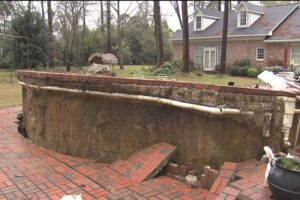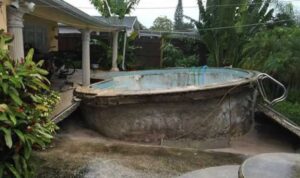
Did you know that draining your pool, regardless of its type, should be avoided at all costs?
Some Houston pool owners may have drained their pools in the past without any issues. However, it is important to recognize the risks involved. Deciding to drain a pool involves significant risks and requires a thoughtful approach. It requires proper planning, timing, and precautionary measures to minimize the risks.
Why is draining a pool so risky? Designers create pools to remain filled with water, and emptying them will cause significant and expensive damage. It is not as simple as just removing the water. Understanding the pool’s conditions and surroundings is crucial to prevent it from coming out of the ground.
Downunda have over two decades of professional experience in aquatic engineering and construction and clearly understand the draining process. Most pool owners underestimate the serious considerations of this critical process. Incorrectly handling the process will result in irreparable damage that cannot be fixed. The stakes are extremely high.
We must emphasize the significance of comprehending the risks linked to draining a pool; it’s crucial and cannot be overstated. Prior to emptying your pool, seek expert advice, be cautious, and adhere to correct protocols for a well-informed decision. Taking these steps can help safeguard your pool and ensure its longevity.
Draining a pool requires careful consideration of various elements, particularly the groundwater conditions and potential weather impacts. Each pool type possesses its own unique prerequisites before safe draining. It is important not to underestimate the impact of groundwater levels and adverse weather. A controllable drainage task may become catastrophic if abrupt heavy rains or unforeseen downpours happen while the pool remains unfilled.
For all types of pools, maintaining a certain water level is crucial for hydraulic stability against external pressures. This principle holds true regardless of the pool’s composition. Concrete and fiberglass pools face the greatest concern with groundwater levels. Elevated groundwater around the pool exerts upward pressure on the pool shell. Hydro-static relief valves, such as the main drain valve, work effectively only when the pool is full or nearly full. Under strong hydro-static forces, an empty pool may struggle to admit water, potentially causing cracks or lifting the pool structure.
Strategic timing is essential, often aligning with dry periods of the year. Efficiently manage groundwater by using methods like sump wells and pumps to drain the pool’s surrounding area effectively. Running a sump pump several days before initiating drainage can help reduce water levels near the pool. It is common practice for re-modelers and pool builders to drill temporary or “Weep” holes into the floor (which they later patch) to relieve hydro-static forces.
People must approach the process with caution and careful consideration. Considering the unique characteristics of the pool, local groundwater conditions, and potential weather disruptions are a must. It is advisable to consult with experienced professionals in pool maintenance and drainage to ensure that you carry out the procedure safely and effectively.

Draining a concrete pool poses significant risks that should not be taken lightly. While concrete is substantial, it is not weighty enough to counteract hydro-static pressure when the pool is drained. This might turn your solid pool into something resembling a “concrete boat,” a scenario you don’t want. This trend is often seen when owners try to clean pools during the springtime. In most cases, the pool does not even fully empty before it starts lifting permanently, often rising several feet out of the ground.
Even if you have drained your concrete pool previously, doing so again without careful consideration can spell trouble. It is highly advisable to seek professional consultation before making the decision to drain your concrete pool. While the structural integrity of a concrete pool can withstand the pressures of empty walls, another critical concern arises from the nature of the pool’s interior surface, typically composed of plaster or pebble. This surface is designed to be continuously hydrated. Allowing the interior surface of your concrete pool to dry out, even for a short duration, can result in the de-lamination of the plaster surface from the underlying shell.
The concrete shell and the interior surface layer consist of different materials, each with its own unique expansion and contraction rates in response to factors like ambient air or, even more concerning, direct sunlight in the height of summer. The presence of water serves to mitigate these disparities and prevents temperature-induced failures in the surface. Therefore, when considering the drainage of a concrete pool, you must not only worry about the structural aspects but also about the potential impact on the quality and lifespan of the costly interior surface of your pool.
In conclusion, due to the intricate interplay between the structural integrity and the interior surface of a concrete pool, it is imperative to exercise extreme caution and seek professional guidance before deciding to drain it. The potential risks to both the pool’s physical structure and its interior finish make this a decision that should not be taken lightly.

Fiberglass-Pool-Popped-Out-of-Ground
Draining a fiberglass pool should be considered with caution when it comes to draining. These pool types are particularly susceptible to issues arising from drainage, especially in regions with high water tables adjacent to the pool. Unlike concrete pools which are quite weighty, fiberglass pools possess significantly less mass relative to their size, making them prone to buoyancy effects that could potentially lift the pool out of the ground when draining.
Concrete pools, though heavy, share the risk of displacement during drainage, but fiberglass pools are more vulnerable due to their lighter weight. There is a possibility of the pool becoming partially airborne due to the upward pressure exerted by the surrounding soil and water table. To counteract this, it is customary practice to install temporary wooden bracing across the pool before initiating drainage, providing the needed support against the forces pushing against the pool’s walls.
Additionally, fiberglass pools often lack the inherent strength required to withstand the external pressure from the surrounding earth. This can lead to twisting, bowing, and even cracking of the pool shell as it struggles against these forces. Even in scenarios where the pool remains grounded, there is a risk of structural failure and cracks emerging due to hydro-static pressure. Repairing such damage can be exceptionally challenging.
Given these concerns, it is crucial that only qualified professionals undertake the task of draining fiberglass pools. They should opt for a time when groundwater levels are naturally low or actively controlled, minimizing the potential for buoyancy and structural damage. Furthermore, meticulous bracing should be employed to reinforce the pool’s structure against the anticipated pressures.
Ideally, the drainage process should be swift, keeping the pool empty for the shortest duration possible. While I often advocate using a garden hose to fill pools as a cost-effective measure, for fiberglass pools, I recommend investing in water trucks to ensure the shortest drainage period.
To ensure the longevity and integrity of fiberglass pools, it is imperative to exercise caution, seek professional assistance, and carefully plan the drainage process to mitigate potential risks.
Contact Downunda Pools today for more information.